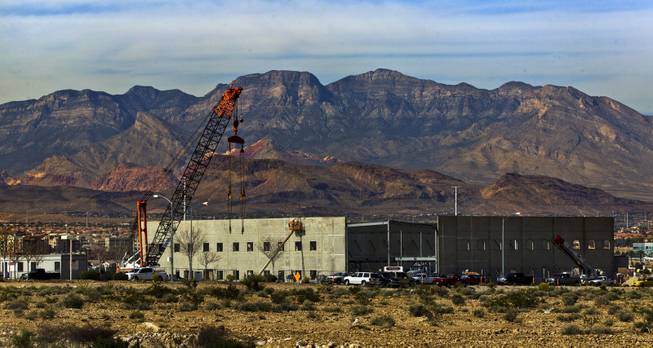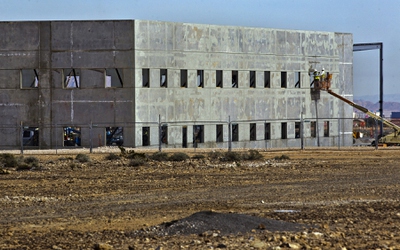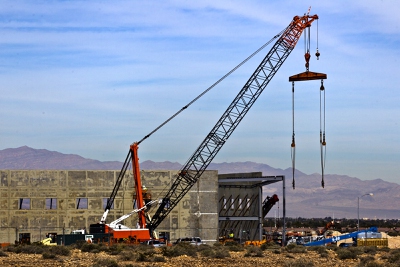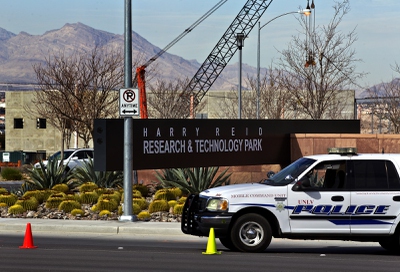
After years of sitting dormant, UNLV’s Harry Reid Research & Technology Park is finally breaking ground on two construction sites on Thursday, February, 19, 2015.
Friday, Feb. 20, 2015 | 2 a.m.
More:
For the first few years of the Harry Reid Research and Technology Park’s existence, the only visible sign of development was the tastefully manicured entrance wreathed in agave plants, golden barrel cacti and a stylish welcome sign.
Until now, that welcome sign didn’t lead to much. Since the recession’s credit crunch put a stop to significant portion of investment in the valley, the 122-acre site on Sunset Road and Durango Drive is the same desert lot it has been since the county land was acquired by UNLV in 2005.
Today, with two tenants signed on for long-term leases and finally beginning construction, university officials are hoping to kickstart their vision of a research nexus that would connect the university’s brightest with eager high-tech companies.
Large concrete walls and cranes have already popped up in the center of the park where Catamaran LLC, an Illinois-based pharmacy management company, is setting up a 100,000-square-foot shop.
Just down Jim Rogers Way, which runs through the center of the complex and was named after the higher education champion in a heartfelt ceremony Thursday, construction is also underway on an expanded campus of the American Preparatory Academy, a K-12 charter school that opened last year.
Millions in federal grants went to finance early operations at the site, but university officials said their luck ran out when the economic downturn scared away developers who had been in talks to begin building.
“About the time we got everything ready for economic development was about six months after the economy of the world collapsed,” said Gerry Bomotti, UNLV’s senior vice president for business and finance. “Things were just in a holding pattern.”
Managed by the UNLV Research Foundation, the park was meant to be kept afloat by lease money, but the lack of tenants forced it instead into six years of dormancy. A part-time employee of the foundation stayed around to keep the park’s marketing materials current, but other than that, there wasn't much movement at the site.
“Isn’t it great to finally see some construction going on here?” said foundation Chairman Ted Quirk at the Thursday ceremony, which featured podium time from a number of local and national policymakers, such as Rep. Dina Titus, D-Nev., and Clark County Commissioner Steve Sisolak.
Catamaran brings with it 353 jobs at an average wage of $23 per hour. The company told the Las Vegas Global Economic Alliance that it chose the property because of Southern Nevada’s status as a shipping hub with a “large pool” of skilled workers in pharmacology, and said it would recruit from local pharmacy schools.
The company also received a $3.4 million incentive package from Gov. Brian Sandoval’s office of economic development.
“The state taking a look at economic development and attracting more tech-oriented companies … has certainly mattered over the last couple of years,” said Thomas Piechota, UNLV’s vice president of research and economic development. “I think that will likely continue.”
Research parks like this one aren’t a new concept. UNLV President Len Jessup, who arrived at the university last month from a business college post at the University of Arizona, said there are tried and true ways to get public and private groups working together.
That state’s other flagship campus, Arizona State University, has a research park that houses around 4,000 employees in 50 companies, many of whom provide space for student collaboration in high-tech areas like solar power and digital communication.
Bomotti said Catamaran has already expressed interest in reaching out to university students through things like internships at the facility.
“It will have a tremendous impact not just on this community but this state and beyond,” Jessup said. “This is the right vision.”
UNLV doesn’t have other companies in line to start building just yet, but Bomotti said interest is growing.
At the moment they are trying to secure an office and laboratories there for the Environmental Protection Agency. The agency has been occupying space at a small group of buildings at UNLV for decades.
“We always believed that this is a great location in the valley,” Bomotti said. “It was just a matter of when.”




Join the Discussion:
Check this out for a full explanation of our conversion to the LiveFyre commenting system and instructions on how to sign up for an account.
Full comments policy